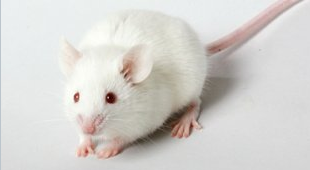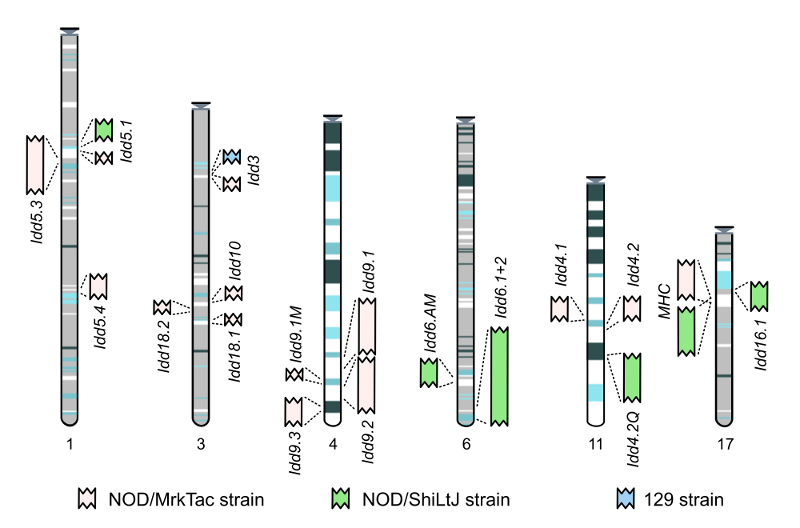
Sequencing of Idd regions in the NOD mouse genome
Archive Page
This page is maintained as a historical record and is no longer being updated.

Background
T1D is a polygenic autoimmune disease that is characterised by hyperglycaemia and is fatal if not treated. It results from the progressive autoimmune T cell-mediated destruction of the insulin-producing pancreatic β-cells of the islets of Langerhans. Disease frequency is attributable to the interaction of the environment on alleles at numerous loci in the genome, with nearly 50 loci known to be involved. T1D is typically associated with specific allelic variants of the Major Histocompatability Complex (MHC) class I and class II genes within the MHC, a region of the genome that is critical for mounting immune and autoimmune responses. To date however, the MHC is the only locus that has been found to be essential for the manifestation of this disease.
The NOD mouse spontaneously develops T1D and is a model organism since it shares multiple characteristics with the human disease. Such characteristics include genetic polymorphisms that affect shared pathways, common antigenic targets, and the expression of class II MHC molecules displaying related peptides. The NOD mouse therefore represents a valuable tool for studying the genetics of T1D and for evaluating therapeutic interventions.
Funding
The NOD bacterial artificial chromosome (BAC) sequencing was funded by Immune Tolerance Network (ITN) Contract AI 15416, which was sponsored by the National Institute of Allergy and Infectious Diseases (NIAID), the National Institute of Diabetes and Digestive and Kidney Diseases (NIDDK), and the Juvenile Diabetes Research Foundation International (JDRF).
BAC libraries
Two NOD mouse BAC libraries were constructed and the BAC ends sequenced. Clones from the DIL NOD BAC library constructed by RIKEN Genomic Sciences Centre (Japan) in conjunction with the Diabetes and Inflammation Laboratory (DIL) (University of Cambridge) from the NOD/MrkTac mouse strain are designated DIL. Clones from the CHORI-29 NOD BAC library constructed by Pieter de Jong (Children’s Hospital, Oakland, California, USA) from the NOD/ShiLtJ mouse strain are designated CHORI-29.
All NOD mouse BAC end-sequences have been submitted to the International Nucleotide Sequence Database Consortium (INSDC), deposited in the NCBI trace archive. We have generated a clone map from these two libraries by mapping the BAC end-sequences to the latest assembly of the C57BL/6J mouse reference genome sequence. These BAC end-sequence alignments can then be visualized in the Ensembl mouse genome browser where the alignments of both NOD BAC libraries can be accessed through the Distributed Annotation System (DAS).
The Mouse Genomes Project has used the Illumina platform to sequence the entire NOD/ShiLtJ genome and this should help to position unaligned BAC end-sequences to novel non-reference regions of the NOD genome. Further information about the BAC end-sequences, such as their alignment, variation data and Ensembl gene coverage, can be obtained from the NOD mouse ftp site.
Library construction, sequencing and mapping details for both NOD mouse BAC libraries.
| Library name | DIL NOD | CHORI-29 NOD |
| Strain name | NOD/MrkTac | NOD/ShiLtJ |
| Source | Female liver | Male kidney |
| Vector | pBACe3.6 | pTARBAC2.1 |
| Originator | RIKEN Genomic Sciences Centre, Japan | Children’s Hospital Oakland, California, USA |
| Contact | Dr. Jayne Danska | BACPAC resources |
| Total number of BAC clones | 196,032 | 110,976 |
| Passed BAC clones | 150,878 | 75,046 |
| BAC clones mapped successfully | 125,266 | 62,162 |
| Passed BAC end-sequences | 332,535 | 170,159 |
| Sanger clone prefix | bQ | bCN |
| Average BAC insert size bp | 149,809 | 205,413 |
| Accession numbers of BAC end-sequences | FR000001-FR332535 | FR332536-FR502694 |

Targeted sequencing
In conjunction with external collaborators studying the genetics of NOD mice, clones covering defined Idd candidate regions were selected for whole BAC sequencing from either of the two NOD mouse libraries using the BAC end-sequence alignments in Ensembl. Sequencing was then carried out using T7 and SP6 primers on the vector, and big dye terminator chemistry. In parallel, the quality of the corresponding sequence in the C57BL/6J reference mouse has been checked. Clones from the DIL NOD BAC library constructed by RIKEN Genomic Sciences Centre (Japan) in conjunction with the Diabetes and Inflammation Laboratory (DIL) (University of Cambridge) from the NOD/MrkTac mouse strain are designated DIL. Clones from the CHORI-29 NOD BAC library constructed by Pieter de Jong (Children’s Hospital, Oakland, California, USA) from the NOD/ShiLtJ mouse strain are designated CHORI-29.
Finished clones from the targeted Idd candidate regions are displayed in the NOD clone sequence section of the website, where they can be downloaded either as individual clone sequences or larger contigs that make up the accession golden path (AGP).
The importance and utility of these high quality finished sequences is demonstrated further by the essential role that the NOD/ShiLtJ strain derived CHORI-29 NOD BACs played in calibrating the variation calling software for the Mouse Genomes Project. All sequences are publicly available via the INSDC.
Manual annotation and analysis
Analysed and manually annotated sequences have been generated using in-house developed software in accordance with the manual annotation guidelines, and are available through the Vertebrate Genome Annotation browser Vega. Completed C57BL/6J annotation can also be viewed in the Vega genome browser alongside the NOD sequence. This allows comparison of the genomic sequence and genes in the candidate loci between diabetes resistant and diabetes sensitive strains, looking for example for SNPs, and is a useful way of identifying regions of difference between the two mouse strains. We have analysed the homologous C57BL/6J mouse and NOD mouse sequences and identified variation consequences. These data are available from the NOD mouse ftp site.
Contact
If you need help or have any queries, please contact us using the details below.